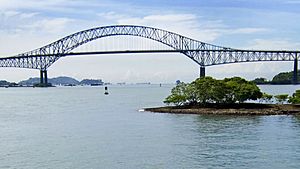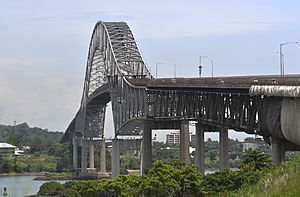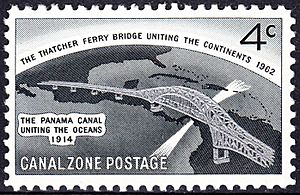Bridge of the Americas facts for kids
Quick facts for kids Bridge of the Americas |
|
|---|---|
 |
|
| Carries | Four lanes of Carretera Panama-Arraijan, pedestrians and bicycles |
| Crosses | Pacific entrance of the Panama Canal |
| Locale | Balboa, Panama |
| Characteristics | |
| Design | Steel through arch bridge John F. Beasly & Company |
| Total length | 1,654 m (5,425 ft) |
| Width | 10.4 m (34 ft) |
| Longest span | 344 m (1,128 ft) |
| Clearance below | 61.3 m (201 ft) at high tide |
| History | |
| Opened | October 12, 1962 |
| Statistics | |
| Daily traffic | 35,000 (2004) |
The Bridge of the Americas (called Puente de las Américas in Spanish) is a very important road bridge in Panama. It crosses the Pacific entrance of the Panama Canal. This bridge connects the land masses of North and South America. It was finished in 1962 and cost about US$20 million. Two other bridges also cross the canal: the Atlantic Bridge and the Centennial Bridge.
Contents
About the Bridge of the Americas
The Bridge of the Americas crosses the Pacific side of the Panama Canal near Panama City. The United States built it between 1959 and 1962. It cost about US$20 million.
For many years, this bridge was a key part of the Pan-American Highway. This highway connects many countries in North and South America. The bridge made it much easier for cars to cross the Canal. Before this bridge, there were only small, movable bridges or ferries.
How the Bridge Was Built
The bridge is a special type called a cantilever bridge. It has a main section that is a tied arch bridge. The whole bridge is 1,654 meters (5,425 feet) long. Its main part is 344 meters (1,128 feet) long.
The highest point of the bridge is 117 meters (384 feet) above the sea. Ships need to pass under it to go through the Panama Canal. The space under the main part is 61.3 meters (201 feet) high at high tide. Some very large cruise ships are too tall to fit under this bridge.
The bridge has wide ramps at each end. It also has walkways on both sides for people to use.
History of the Bridge
From the very start of the Panama Canal project, people knew there would be a problem. The canal would split cities like Panama City from the rest of the country. Even during construction, workers had to use barges to cross.
Why a Bridge Was Needed
After the canal opened, more and more cars were on the roads. A new road was built to western Panama. This made the need for a good way to cross the canal even bigger.
In 1931, two new ferries, the Presidente Amador and President Washington, started helping. More ferries were added later, especially for the military. In 1942, a small road and rail bridge opened at the Miraflores locks. But it could only be used when no ships were passing. Everyone knew a much bigger bridge was needed.
Building the Bridge
People had been talking about building a permanent bridge since 1923. Panama kept asking the United States, which controlled the Canal Zone, to build it. In 1955, the Remón-Eisenhower treaty made the U.S. promise to build the bridge.
John F. Beasly & Company won the contract to build the bridge. They used steel and strong concrete. Construction started on October 12, 1959. It took almost two and a half years to finish.
The bridge officially opened on October 12, 1962. There was a big ceremony. Many people came to walk across the bridge. The event was shown on radio and TV across Panama.
After the Bridge Opened
When it first opened, the bridge was a very important part of the Pan-American Highway. About 9,500 vehicles crossed it every day. But over time, this number grew a lot. By 2004, about 35,000 vehicles used it daily.
This made the bridge very crowded. So, the Centennial Bridge was built to help. Now, the Pan-American Highway also uses the Centennial Bridge. In 2010, a cargo ship hit one of the bridge's protective bases. The bridge was not damaged, and no one was hurt.
The "Thatcher Ferry Bridge" Name
The bridge was first called "Thatcher Ferry Bridge." This name came from an old ferry that crossed the canal nearby. The ferry was named after Maurice H. Thatcher. He was a former member of the Canal Commission. He was also the one who cut the ribbon at the bridge's opening.
However, the government of Panama did not like this name. They wanted it to be called "Bridge of the Americas." Ten days before the opening, Panama's National Assembly officially decided this.
They passed a resolution that said:
- The bridge over the Panama Canal must be called "Bridge of the Americas."
- This name should be the only one used for the bridge.
- Panamanian officials should not accept any documents using a different name.
- Copies of this decision would be sent to governments worldwide. This was to make sure everyone used the name chosen by the people of Panama.
Even though the ceremony included a "Thatcher Ferry Bridge March," U.S. officials also used the name "Bridge of the Americas." The official name stayed "Thatcher Ferry Bridge" until Panama took control of the Canal Zone in 1979.
There were even Postage stamps made with the name "Thatcher Ferry Bridge." On one sheet of these stamps, there was a famous mistake where the bridge was missing!
See also
 In Spanish: Puente de las Américas para niños
In Spanish: Puente de las Américas para niños
- Crossings of the Panama Canal
- The Pan-American Highway
- The Centennial Bridge
- Postage stamps and postal history of the Canal Zone
- List of bridges in Panama






